
As a distributed team, we find online business tools indispensable because we rely on them so heavily to collaborate and create our collective office space in the cloud. We know the beating heart of running a successful business is successful communication internally as a team and externally with our customers — and without helpful tools, we can’t connect.
We’ve rounded up our seven favorite business tools that keep us moving forward. What these seven business tools have in common is that they’re easy to use and responsive to our needs. And when business tools can evolve as we evolve while retaining their simplicity and effectiveness, they have great staying power.
Here’s the quick list:
– Help Scout is our customer happiness tool
– Buffer is our social sharing tool.
– Asana is our technical blueprint.
– Trello is our content organization tool.
– HipChat is our virtual office chat tool.
– Hackpad is our weekly wiki tool.
– iDoneThis is our workday progress snapshot.
Help Scout — creating customer happiness
We manage customer support emails in Help Scout, which provides a centralized, coordinated system that enables us to send personalized emails that still look just like we’re sending them from our idonethis.com inboxes. Nobody likes to feel like just another customer number.

Our Chief Happiness Officer, Ginni spends the most time in Help Scout. In addition to handling the bulk of support issues, she helps direct email traffic, whether it’s assigning email based on area of expertise or an existing connection from a past conversation. Help Scout also allows us to write notes, which is key as an email can change hands when it’s assigned or when we’re pitching in during a support swarm.
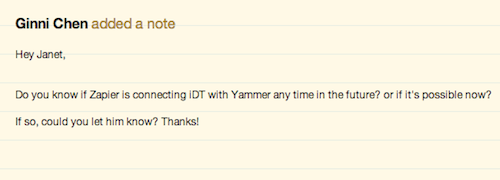
What’s great for the rest of the team is that we can reply from our inboxes when we get an email notification of an assignment, rather than having to head over the Help Scout itself.
Customer happiness isn’t just about solving existing problems and bugs but listening to what people have to say. When an email goes through Help Scout, it’s usually an opportunity to improve our product or service. We’ll use tags to keep track of recurring bugs, feature requests, or specific projects we want to keep an eye on for future reference.
Buffer — strategic social sharing
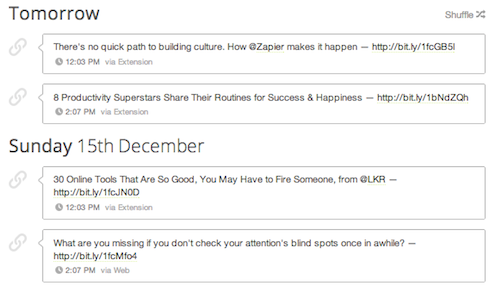
We use Buffer to share our content as well as other articles we think the iDoneThis community will enjoy on Twitter, Facebook, LinkedIn, and Google+.

Buffer helps us approach our social sharing in a strategic way. On the front-end, we can schedule our social media posts by filling up — well, buffering — a queue for each channel, spacing them on a set schedule out so we’re not overloading timelines and feeds.
Since Buffer allows us to batch our posting activity, we’re not spending too much time on social media throughout the day — and we can always buffer an article or an image quickly using the Chrome extension. Then we can look at the analytics to gain insight into what kind of approach worked best to engage our followers on each channel.
We’re using Buffer for Business on the small business plan, which allows us to connect up to 25 different accounts. Many of us use Buffer to share iDoneThis-related content on some of our own personal social media accounts, so the new team collaboration features are coming in handy.
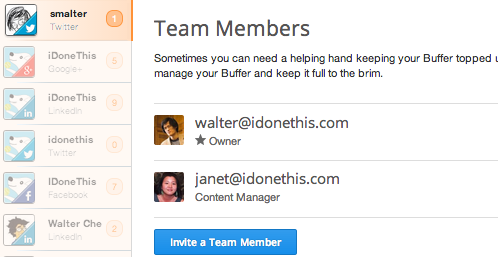
We can assign other people as managers, who can post on your behalf with the same permissions as you, or as contributors, who have limited access and whose posts require your approval to be added to your queue.
Asana — smart technical blueprint
We rely on Asana to manage engineering projects. It’s our evolving blueprint business tool.
For each project in Asana, there are three stages of tasks:
1.The spec phase is where we figure out what needs to be done and in what order, make planning planning decisions, or investigate to find out necessary information.
2. The implementation phase is where we bring the project to life.
3. The post-launch phase is for tasks that remain but aren’t integral for the launch to happen.
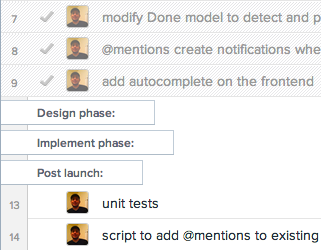
What’s especially useful about Asana is that it handles a project’s evolution gracefully, managing changes to existing tasks and the generation of new tasks. For example, the post-launch stage often starts out empty and then fills up as we go and have gained a better understanding, or progression into the implementation stage might call for more spec. Throughout the process, the conversation stays in Asana, close to the lists and tasks being discussed and out of inboxes as scattered thoughts and information.
Trello — handy content organizer
We’ve found Trello’s storyboard-like setup useful for keeping our content efforts organized and gaining an easy overview of the content process from concept to published.

We’ll store ideas, references, and links as cards in the Ideas column, which serves as a source for planning out content for the iDoneThis blog or for pitching outside publications. A card will then move through the drafting, send/editing, and finally published lists to indicate where it is in the process. Throughout, we’ll add comments and updates that are more granular, such as noting when we checked in on a pitch.
By designating iDoneThis content with a purple label, we can also see the balance of our content at a glance. Our Trello content board not only helps us keep track of our content pipeline but also make decisions on what needs doing next, whether it’s nudging a guest poster if a card has been draft for too long or sending out more pitches if there’s been too long a streak of posting only on our own blog.
HipChat — virtual office space
Since we’re a remote team, the group chat and instant messaging business tool HipChat is integral as our virtual office. This is where we “show up” for work every day and can display an away message to let people know when we’ve stepped out for lunch, a workout, or a walk. The desktop and iPhone app make using HipChat extremely easy from wherever we are — behind the desk or on the go.

We use HipChat for everything from asking quick questions to hashing out a problem to socializing with some watercooler talk. Since HipChat is a channel that’s real-time but relatively non-disruptive, you can dip in and out of the app when you’re not having an active conversation. Plus, chats are archived, so there’s a record if you want to look up something or catch up with the chatter if your work hours are out of step with other people’s or if you were out for part of the day.
Hackpad — easy weekly wiki
While we use Draft, a collaborative writing and editing business tool with version control for our blog and content projects, we’ve started using Hackpad for collaborative internal documents and fast, smart wikis.

Recently, co-founders Walter and Rodrigo started writing a weekly “bench memo” (there are some holdovers from Walter’s time as a lawyer). The memo lays out any formalized decisions and their rationales in a succinct one-page document.
Bench memos began in response to two problems. We realized we sometimes fell into discussing the same issues repeatedly without coming to a decision, so this allows co-founders to direct the conversation forward instead of everyone going around in circles. Also, people sometimes heard about decisions after the fact or not hear its reasoning — often a result of independent work areas — so the memo helps fill in the gaps.
Since Hackpad shows changes in real time with clear attributions of who’s making them, Walter and Rodrigo find it very easy to work on the memo at the same time. And they appreciate how simple it is to share a document. All you need to share the pad, by default, is the URL you see in front of you, no permissions or email addresses required.
iDoneThis — simple syncing
We use our own business tool to help us move forward together as a team. iDoneThis provides a collective snapshot of the previous workday so we can start out today on the right foot with an understanding of what’s going on without having to backtrack.
Basically, we reply to an email reminder at the end of the day, asking “What’d you get done today?” The next day, the team gets an email digest of everyone’s responses, which are also recorded in a web calendar.
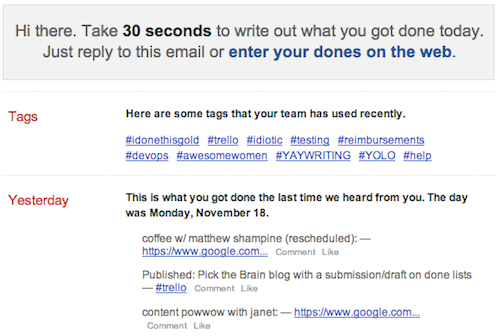
To help avoid the redundancy of re-entering information from other business tools, we user Zapier to automatically post items like meetings and calls scheduled in Google Calendar as dones. The engineers use our GitHub integration to automatically bring their commits into iDoneThis.
Our work isn’t contained neatly in one common box. So iDoneThis is the beacon that everyone makes sure to pay attention to. Ginni won’t be in Asana all day to keep up with all the technical progress and planning — nor should she be — but with the email digests, she’ll have a general knowledge of what’s going on and be able to provide better customer support.
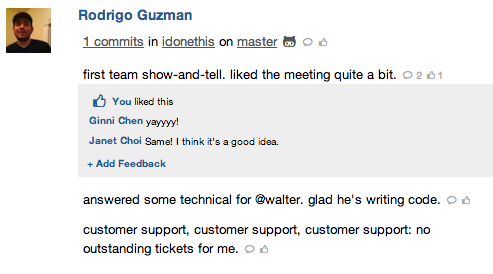 Unlike the more concrete task-oriented Asana or organizational view of Trello, iDoneThis offers us a place to record our progress of the day with various levels of concreteness and aggregation. We can do some of our thinking out loud as we write about our day and fill in context around tasks. This transparency also gives us an opportunity for support and feedback. We can “like” a done to help celebrate a win or ask a question in the comments.
Unlike the more concrete task-oriented Asana or organizational view of Trello, iDoneThis offers us a place to record our progress of the day with various levels of concreteness and aggregation. We can do some of our thinking out loud as we write about our day and fill in context around tasks. This transparency also gives us an opportunity for support and feedback. We can “like” a done to help celebrate a win or ask a question in the comments.
What are some business tools that you use to move your company forward?
Liked this guest post? Subscribe to our free newsletter for more great content on productivity, management, and how to work better!
Photo: Windell Oskay/Flickr
